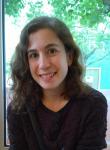Sunshine, Hannah

Hannah is in the Molecular, Cellular, & Integrative Physiology home area. She joined the CMB training program in 2016. Her research mentor is Dr. Luisa Iruela-Arispe. She received a B.S. in Cellular and Developmental Biology in 2012 from Cal State University Fullerton.
Mentor: Dr. Luisa Iruela-Arispe
Molecular Signaling Required for the Establishment and Maintenance of Cell-Cell Adhesion
The vascular endothelium forms a complex network of tubular structures essential for regulating vascular permeability, coagulation, and blood pressure. Consequently, endothelial homeostasis is necessary for the prevention of vascular disease. Apart from various humoral factors, such as cytokines and metabolic products, biomechanical stimulation in the form of hemodynamic forces also regulates endothelial physiology. Shear affects endothelial cell (EC) shape, suppresses proliferation, reduces angiogenic potential and enhances barrier function. While it is known that these responses are mediated by load-bearing subcellular structures – plasma membrane, cell-adhesion complexes and the cytoskeleton – the mechanisms by which cells adapt to dynamic mechanical stimuli are fundamental to understanding the homeostatic regulation of vasculature.
Specifically, I am interested in the interactions between scaffolding protein membrane associated guanylate kinase, WW and PDZ domain containing protein 1 (MAGI-1) and its interactions with Notch signaling. Preliminary data generated in our lab has identified Notch1 as the most prevalent receptor found in human aortic endothelial cells (HAECs) and pointed to the requirement of Notch1 for endothelial homeostasis under flow. Various other studies have shown that MAGI-1 acts as a scaffold for delta-like ligand 1 (DLL1), anchoring the protein at the cell membrane, where its otherwise high affinity for endocytosis would likely reduce the successful binding to Notch receptors. Using a combination of in vitro cell culture with cone-and-plate and IBIDI fluidics devices to simulate laminar flow and in vivo EC specific Cdh5 KD of Notch1, I aim to examine whether MAGI-1 stabilizes DLL1 assisting in the maintenance of stable endothelial cell-cell adhesion under flow.


